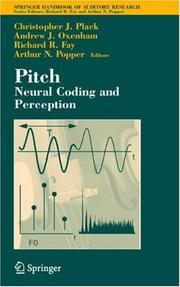| Listing 1 - 10 of 51 | << page >> |
Sort by
|
Periodical
ISSN: 23863137 23408170 Year: 2013 Publisher: Bilbao, Spain : Tuning Academy,
Abstract | Keywords | Export | Availability | Bookmark
 Loading...
Loading...Choose an application
- Reference Manager
- EndNote
- RefWorks (Direct export to RefWorks)
Education, Higher --- Tuning. --- Musical pitch --- Musical temperament
Book
Year: 2020 Publisher: Frontiers Media SA
Abstract | Keywords | Export | Availability | Bookmark
 Loading...
Loading...Choose an application
- Reference Manager
- EndNote
- RefWorks (Direct export to RefWorks)
This eBook is a collection of articles from a Frontiers Research Topic. Frontiers Research Topics are very popular trademarks of the Frontiers Journals Series: they are collections of at least ten articles, all centered on a particular subject. With their unique mix of varied contributions from Original Research to Review Articles, Frontiers Research Topics unify the most influential researchers, the latest key findings and historical advances in a hot research area! Find out more on how to host your own Frontiers Research Topic or contribute to one as an author by contacting the Frontiers Editorial Office: frontiersin.org/about/contact
executive function --- cognitive control --- neural plasticity --- music training --- prefrontal cortex --- neural oscillation --- absolute pitch --- longitudinal study
Book
ISBN: 9789401482691 Year: 2022 Publisher: Leuven LannooCampus
Abstract | Keywords | Export | Availability | Bookmark
 Loading...
Loading...Choose an application
- Reference Manager
- EndNote
- RefWorks (Direct export to RefWorks)
Een globale pandemie heeft voor salesprofessionals van de ene op de andere dag hun vertrouwde salesbenadering overhoop gehaald. Verkopen op afstand was de enige reddingsboei, maar deze virtuele manier van verkopen eiste een upgrade van mindset en vaardigheden. De nieuwste categorie topverkopers werkt hybride en benadert klanten via diverse kanalen. Videocalls, telefoon en sociale media zijn een evenwaardige aanvulling op face-to-face gesprekken. Bovendien is de hybride verkoper een veranderingsarchitect: hij daagt klanten uit om bestaand gedrag, tools en processen anders te bekijken. Dit alles vanuit het creëren van verbinding, letterlijk en figuurlijk.In De hybride verkoper krijg je een complete handleiding om jezelf als salesprofessional te upgraden naar of aan te scherpen in je rol als hybride verkoper.Bron: www.acco.be
Organization theory --- Marketing --- verkooptechniek --- retailmarketing --- marketingcommunicatie --- e-commerce --- Salesmanagement --- Sales promotion --- Verkooptechniek --- Verkoop --- Hybride werken --- Microsoft --- Pitch --- Zakelijke communicatie --- Verkooptechnieken.
Book
ISBN: 9789401487566 Year: 2023 Publisher: Leuven LannooCampus
Abstract | Keywords | Export | Availability | Bookmark
 Loading...
Loading...Choose an application
- Reference Manager
- EndNote
- RefWorks (Direct export to RefWorks)
De telefoon gaat: "Michael, mensen zijn geïnteresseerd in ons product, we maken massa's offertes. En dan... niks. Radiostilte." Ik antwoord met één vraag: "Waarom moet een klant vandaag van jou kopen? Waarom nu?" Als er dan ook radiostilte volgt, wijst dat erop dat het verkoopverhaal niet goed zit, een probleem dat Humblet ziet terugkomen bij 90% van de bedrijven die hij helpt schalen.Steeds kreeg hij dezelfde vraag: 'Wat doe je nadat je je leadmachine hebt gebouwd? Welk verhaal vertel je aan een lead die binnenkomt? Hoe versnel je je verkoopproces en krijg je een handtekening onder die deals?' Wel: zo.Na meer dan 500 salespitches te hebben rechtgetrokken, deelt Humblet de vijf elementen die nodig zijn om van prospects klanten te maken. Why Now geeft use cases en legio voor- en na-voorbeelden. Dit boek is een blauwdruk om je eigen website, pitch, brochure of salestalk on point te krijgen. Het is een salesflow waar je geen speld tussen krijgt, it's closing time!Bron: www.lannoo.be
Ondernemen. --- Verkooptechnieken. --- Verkooptechniek --- Pitch --- Sales promotion --- Salesmanagement --- Merkbeleid --- Merkstrategie --- Branding --- Marketing --- Productperceptie --- Consumer behavior --- Distribution strategy --- Mass communications --- verkooptechniek --- onderhandelen --- verkoop --- klantentevredenheid

ISBN: 1280608102 9786610608102 0387289585 0387234721 1441920110 Year: 2005 Volume: v. 24 Publisher: New York, NY : Springer,
Abstract | Keywords | Export | Availability | Bookmark
 Loading...
Loading...Choose an application
- Reference Manager
- EndNote
- RefWorks (Direct export to RefWorks)
Although pitch has been considered an important area of auditory research since the birth of modern acoustics in the 19th century, some of the most significant developments in our understanding of this phenomenon have occurred comparatively recently. In auditory physiology, researchers are now identifying cells in the brainstem and cortex that may be involved in the derivation of pitch. In auditory psychophysics, dramatic developments over the last several years have changed our understanding of temporal pitch mechanisms, and of the roles of resolved and unresolved harmonics. Computational modeling has provided new insights into the biological algorithms that may underlie pitch perception. Modern brain imaging techniques have suggested possible cortical locations for pitch mechanisms. This timely volume presents recent findings, while emphasizing their relation to the discoveries of the past. It brings together insights from several different methodological areas: physiology, psychophysics, comparative, imaging, etc., in addressing a single scientific problem. Pitch perception can be regarded as one of the main problems of hearing, and the multidisciplinary approach of the book provides a valuable reference source for graduate students and academics. Christopher J. Plack is Professor in the Department of Psychology at the University of Essex, U.K. Andrew J. Oxenham is a Principal Research Scientist of the Research Laboratory of Electronics at the Massachusetts Institute of Technology, Cambridge, MA. Richard R. Fay is Director of the Parmly Hearing Institute and Professor of Psychology at Loyola University of Chicago. Arthur N. Popper is Professor in the Department of Biology and Co-Director of the Center for Comparative and Evolutionary Biology of Hearing at the University of Maryland, College Park.
Auditory perception. --- Musical pitch. --- Pitch, Musical --- Music --- Sound perception --- Hearing --- Perception --- Word deafness --- Acoustics and physics --- Neurobiology. --- Neurosciences. --- Human physiology. --- Otorhinolaryngology. --- Human Physiology. --- Ear, nose, and throat diseases --- ENT diseases --- Otorhinolaryngology --- Medicine --- Neural sciences --- Neurological sciences --- Neuroscience --- Medical sciences --- Nervous system --- Human biology --- Physiology --- Human body --- Neurosciences
Book
ISBN: 9789027206725 9027206724 9789027288424 9027288429 1282558633 9786612558634 Year: 2010 Volume: 91 Publisher: Amsterdam Philadelphia John Benjamin
Abstract | Keywords | Export | Availability | Bookmark
 Loading...
Loading...Choose an application
- Reference Manager
- EndNote
- RefWorks (Direct export to RefWorks)
This study concerns the interaction of 'focus' with the verbal system of Ejagham, an Ekoid Bantu language. In particular it concerns the multiple forms of the perfective and imperfective aspects. The Ejagham system differs from the tendency in Bantu systems. The verb forms in Ejagham have a 'constituent' focus form that sub-categorizes predicates ("verbs") with terms ("nps"), and an 'operator' focus form used whenever the verbal operator is within the scope of focus. Bantu languages commonly have a form used when the verbal complement falls within the scope of focus but another form for other cases. So Bantu languages tend to group predicates with verbal operators. In addition, Ejagham conflates assertive and contrastive focus, a distinction that is important in other Bantoid languages in the general vicinity of Ejagham but not in Ejagham.
African languages --- Focus (Linguistics) --- Intonation (Phonetics) --- Typology (Linguistics) --- Grammar, Comparative --- Phonetics --- Grammar --- Grammar, Comparative and general --- Language and languages --- Linguistics --- Pitch (Phonetics) --- Prosodic analysis (Linguistics) --- Tone (Phonetics) --- Oral interpretation --- Discourse analysis --- Intonation --- Topic and comment

ISBN: 1781703353 1847793967 9781847793966 1847795994 0719067545 0719067553 Year: 2006 Publisher: Manchester Manchester University Press
Abstract | Keywords | Export | Availability | Bookmark
 Loading...
Loading...Choose an application
- Reference Manager
- EndNote
- RefWorks (Direct export to RefWorks)
Geoffrey Hill has said that some great poetry 'recognises that words fail us'. These essays explore Hill's struggle over fifty years with the recalcitrance of language. This book seeks to show how all his work is marked by the quest for the right pitch of utterance whether it is sorrowing, angry, satiric or erotic. It shows how Hill's words are never lightly 'acceptable' but an ethical act, how he seeks out words he can stand by - words that are 'getting it right'.This book is the most comprehensive and up-to-date critical work on Geoffrey Hill so far, covering all his work up to 'Scenes from
Hill, Geoffrey --- Criticism and interpretation. --- Literature --- Literary Studies: Poetry & Poets --- LITERARY CRITICISM / European / English, Irish, Scottish, Welsh --- Ireland --- Geoffrey Hill. --- Scenes from Comus. --- language. --- pitch. --- poems. --- poetry. --- recalcitrance. --- satiric. --- sorrowing. --- utterance.
Book
ISBN: 0253055733 Year: 1987 Publisher: Indiana University Press
Abstract | Keywords | Export | Availability | Bookmark
 Loading...
Loading...Choose an application
- Reference Manager
- EndNote
- RefWorks (Direct export to RefWorks)
The concept of affinities, or pitch relationships, was fundamental to modal theory in the Middle Ages and the early Renaissance. For the first time, Delores Pesce brings together theoretical perspectives on this subject from the end of the ninth century to the middle of the sixteenth, spanning the ideas of Hucbald through Guido of Arezzo, Jacques de Liège, Marchetto of Padua, Tinctoris, and Aaron to those of Glareanus. Pesce provides a comprehensive survey of problematic chants and of medieval solutions for them. She also traces the arguments that led to the rejection of the affinities and the acceptance of transposition in the modern sense. Scholars will find this volume invaluable for addressing issues related to modal classification and notational practices, in both chant and polyphony.
Transposition (Music) --- Musical intervals and scales. --- Music theory. --- Music theory --- History --- Intervals (Music) --- Modes, Musical --- Music --- Musical modes --- Musical scales and intervals --- Scales (Music) --- Musical temperament --- Transposing (Music) --- Musical pitch --- Musical theory --- Theory of music --- Modes --- Theory --- History of music
Book
ISBN: 3484305088 9783484305083 3110921200 9783110921205 Year: 2006 Volume: 508 Publisher: Tübingen Niemeyer
Abstract | Keywords | Export | Availability | Bookmark
 Loading...
Loading...Choose an application
- Reference Manager
- EndNote
- RefWorks (Direct export to RefWorks)
This book addresses students and researchers of both phonetics and phonology, and the semantics and pragmatics of discourse. It employs an autosegmental-metrical model of intonation to investigate the marking of aspects of information structure, concentrating on the Given-New dimension. It begins with an overview of the state of the art in the areas of intonation and information structure, and, since the term 'Givenness' has been used in the literature in diverging ways, provides a model of 'Givenness proper', focusing on the cognitive states of discourse referents, and how these states are expressed through the choice of words and their prosody. The empirical evidence provided here is based on German. It comprises the analysis of a read corpus and two perception experiments which show that the dichotomy of 'accented' versus 'unaccented' corresponding to 'New' versus 'Given' information is inadequate. In fact, there is evidence that a range of pitch accent types (including deaccentuation) can be mapped onto the gradient scale of Givenness degrees, with the pitch height on the accented syllable being the determining factor.
Cognition. --- Discourse analysis. --- German language --- Intonation (Phonetics) --- Pragmatics. --- Semantics. --- Intonation. --- Intonation (Phonetics). --- Psychology --- Pragmalinguistics --- General semantics --- Language and languages --- Logic, Symbolic and mathematical --- Semantics (Philosophy) --- Formal semantics --- Semasiology --- Semiology (Semantics) --- Comparative linguistics --- Information theory --- Lexicology --- Meaning (Psychology) --- Discourse grammar --- Text grammar --- Semantics --- Semiotics --- Grammar, Comparative and general --- Linguistics --- Pitch (Phonetics) --- Phonetics --- Prosodic analysis (Linguistics) --- Tone (Phonetics) --- Oral interpretation --- Philosophy --- Intonation

ISBN: 1280726776 9786610726776 1402047967 1402047959 1402047975 Year: 2007 Volume: 82 Publisher: Dordrecht : Springer Netherlands : Imprint: Springer,
Abstract | Keywords | Export | Availability | Bookmark
 Loading...
Loading...Choose an application
- Reference Manager
- EndNote
- RefWorks (Direct export to RefWorks)
This book contains a collection of papers exploring the cross-linguistic expression of topic and focus. A diverse set of perspectives from some of the leading scholars in the areas of semantics and intonation are represented in the collection, which is based on papers presented at the Topic and Focus Workshop at the 2001 LSA Summer Institute in Santa Barbara. This book is unique in the breadth of its typological coverage of topic and focus phenomena. Material is presented from nine languages, including several that are severely under-documented from a theoretical perspective. The expression of topic and focus are integral aspects of linguistic communication that introduce the content of discourse and emphasize its most crucial elements. Topic and focus phenomena are complex and involve both a meaning and a prosodic component. This book is the first collection of papers devoted to the rigorous examination of both semantic and intonational features of topic and focus from a broad typological perspective.
Focus (Linguistics) --- Intonation (Phonetics) --- Grammar, Comparative and general. --- Grammar, Comparative and general --- Language and languages --- Linguistics --- Pitch (Phonetics) --- Comparative grammar --- Grammar --- Grammar, Philosophical --- Grammar, Universal --- Philosophical grammar --- Intonation --- Grammar, Comparative --- Linguistics. --- Linguistics, general. --- Philology --- Phonetics --- Prosodic analysis (Linguistics) --- Tone (Phonetics) --- Oral interpretation --- Discourse analysis --- Topic and comment --- Linguistic science --- Science of language --- Cross-linguistic perspectives --- Meaning
| Listing 1 - 10 of 51 | << page >> |
Sort by
|

 Search
Search Feedback
Feedback About UniCat
About UniCat  Help
Help News
News